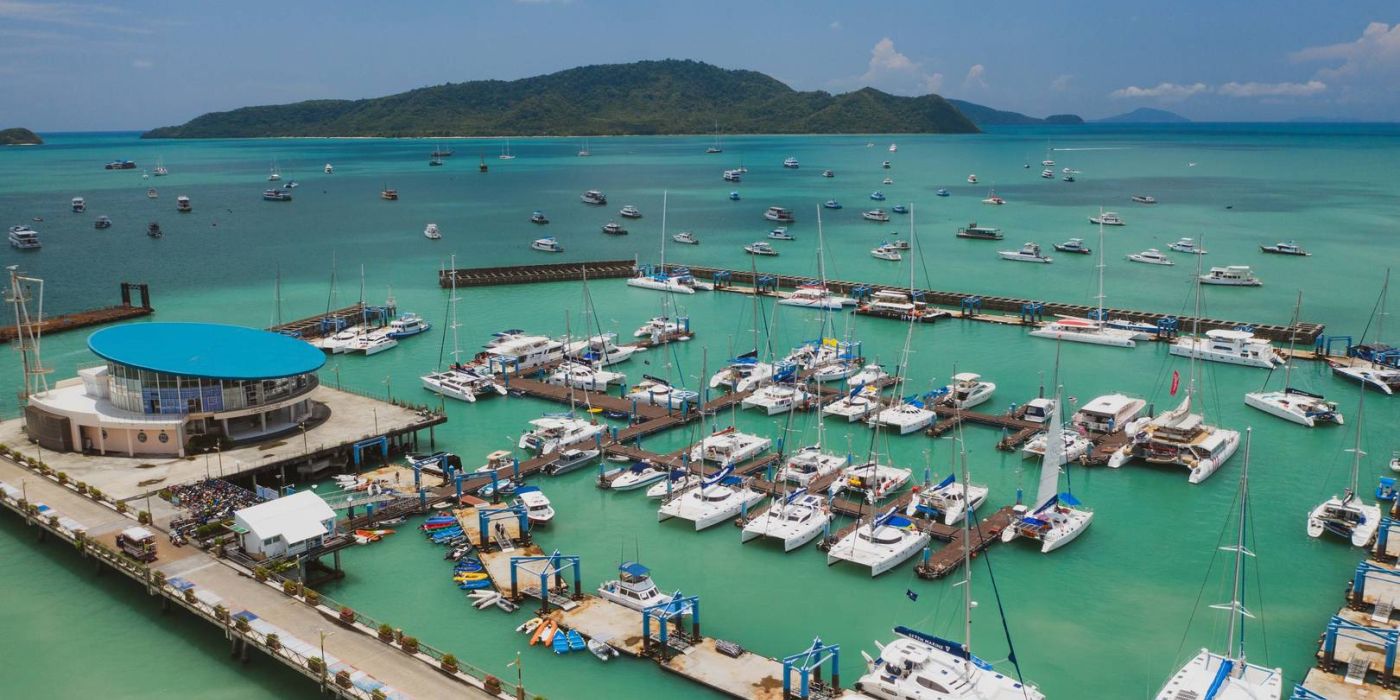Thailand Economy Review
Thailand is a good example of an emerging economy that, through economic growth and social development, has been able to quickly move from being an undeveloped country to becoming an emerging economy in the world. Back in 1980, the kingdom was classified as a low-income country. In the period from 1960 to 1996, the country's economy grew at an average rate of 7.5% and by 5% in the period from 1999 to 2005.
In 2010, the World Bank upgraded Thailand to an upper-middle-income country. The rapid growth had a beneficial effect on the indigenous population of the country and on foreigners associated with the economy of the kingdom. Over the past half century, the economic boom has created millions of jobs and allowed countless residents to improve their financial situation and social status. Now hunger has been completely eliminated in the country and the majority of the population has access to quality medicine and good education.
Thailand is the second largest economy in Southeast Asia, just after Indonesia. As of 2022, Thailand's GDP per capita was just over US$7,000. The Kingdom ranks 4th in terms of GDP per capita in Southeast Asia. In 2018, Thailand's international reserves stood at just over US$237 billion. This is the 2nd highest figure, right after Singapore. In terms of foreign trade volume, the kingdom ranks 2nd in Southeast Asia. The country's current account surplus ranks 10th in the world and amounted to about $38 billion at the time of 2018.
Thailand Economy by Sector
Perhaps one of the main factors influencing the stability of the national currency and the country’s economy as a whole is the diversification of its economic sectors. The more diverse the areas of activity in which the country’s economically active population is involved, the more stable the economy and its national currency show themselves.
Contrary to the popular belief of most of our compatriots from the CIS countries, the Thai economy is not only tourism. In the country's economy, about 35% of GDP comes from the industrial sector and 8.8% from agriculture. The service sector, which includes tourism, occupies 56.2%, which indicates the development of the country’s economy as a whole.
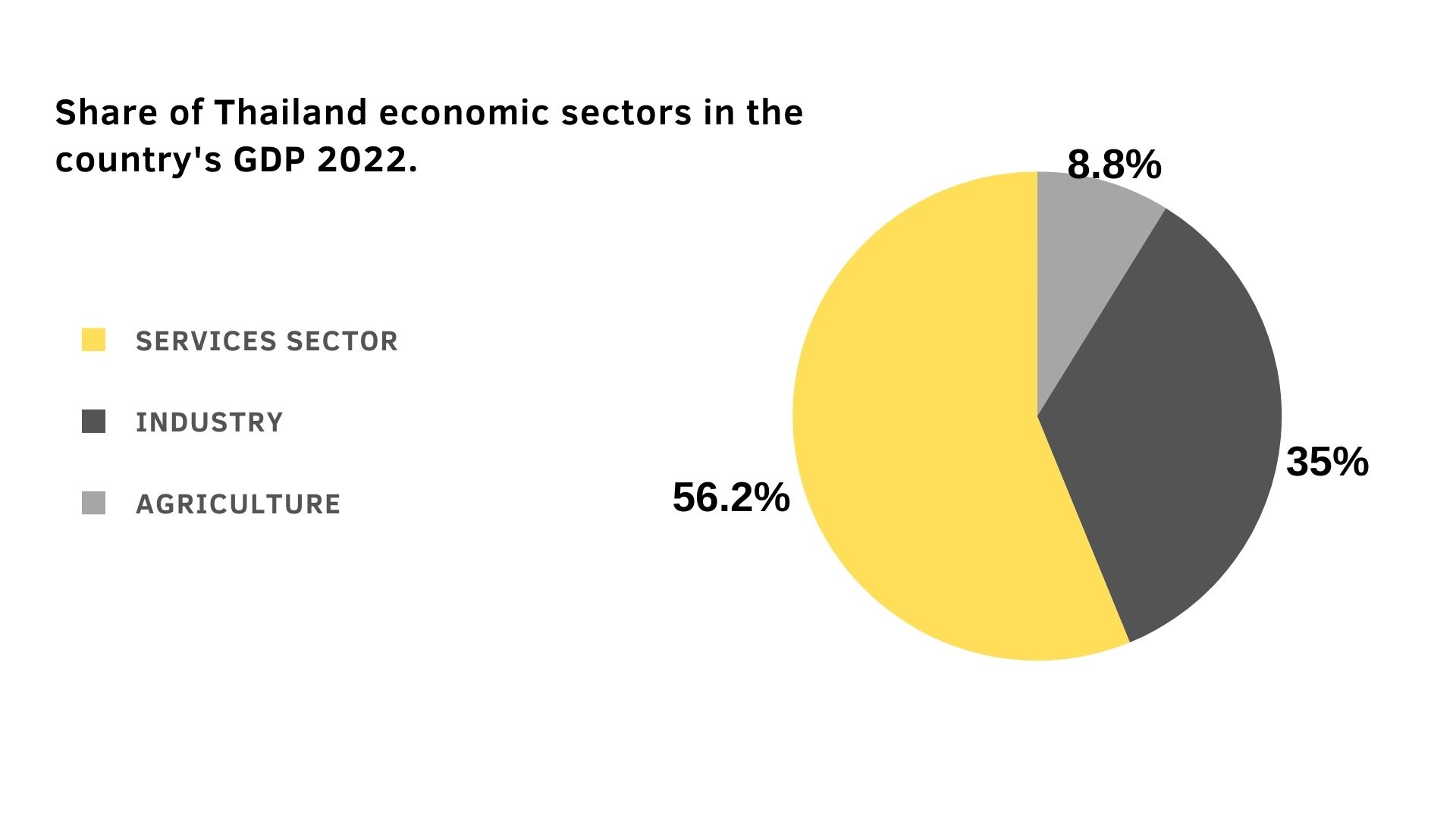
Sourse - Thailand - share of economic sectors in the gross domestic product 2022 | Statista
Thailand's international trading partners
China and Japan are Thailand's key import partners. They account for more than 60% of the total volume. The key export partners are China and the USA, accounting for 70% of the total. Below are Thailand's key international partners.
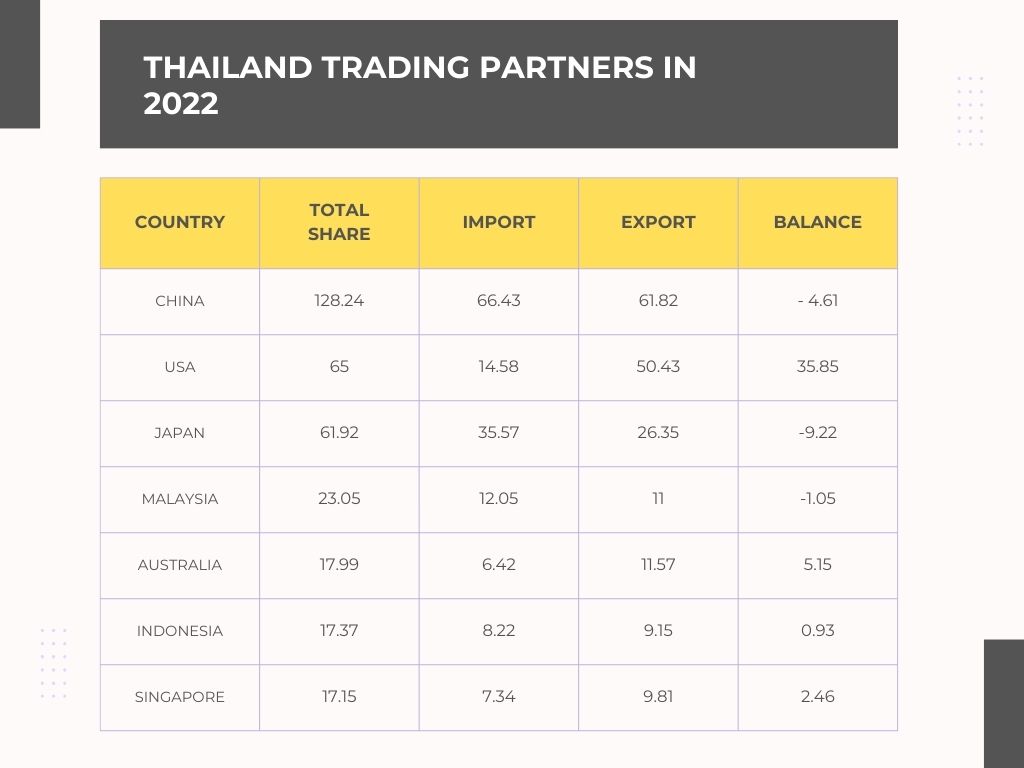
Source - Economy of Thailand - Wikipedia
Key products exported from Thailand 2021
Key products exported from Thailand 2021
The goods exported from Thailand are very diverse. In 1st place are spare parts and accessories for office equipment - 7.55%. Information and communication technologies are in 2nd place - 4.76%. Electronic integrated circuits are in 3rd place in exports - 4.24%. High-tech goods and services account for a key share of Thailand's exports, placing the country on par with other Asian countries that produce high-tech products.
The image below presents a Treemapping data visualization for the country's key export goods and services.
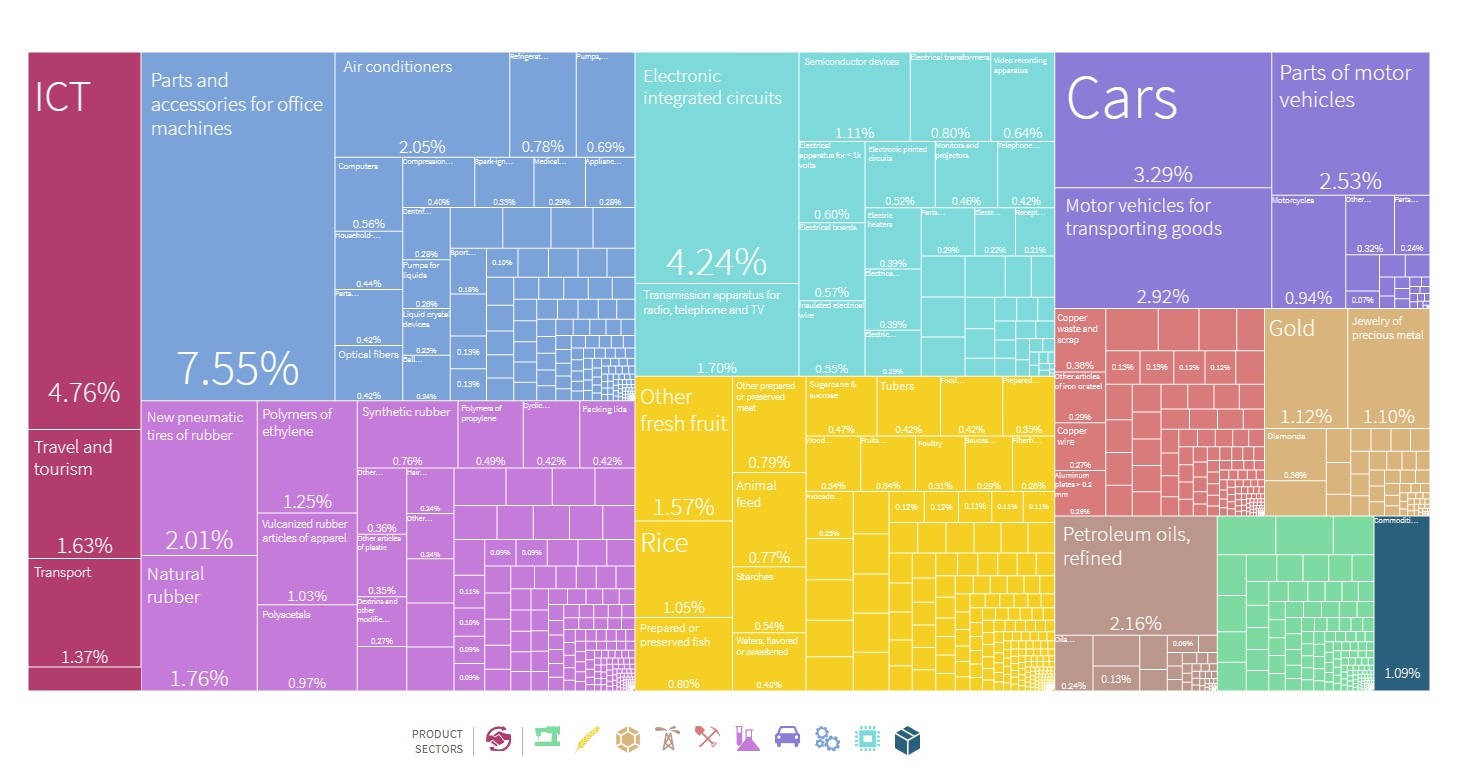
Source - The Atlas of Economic Complexity (harvard.edu)
The following are the main goods and services exported by Thailand in 2021.
Services
Information and communication technologies - 4.76%;
Tourism - 1.63%;
Transport - 1.37%
Appliances
Spare parts and accessories for office equipment - 7.55%
Air conditioners - 2.05%
Refrigerators - 0.78%
Agro-industrial complex
Fresh fruit - 1.57%
Rice - 1.05%
Cooked or canned fish - 0.80%
Prepared or canned meat – 0.79%
Electronics
Electronic integrated circuits - 4.24%
Transmitting equipment for radio, telephone and television - 1.70%
Semiconductor devices - 1.11%
Electrical transformers - 0.80%
Transport
Cars - 3.29%
Auto parts - 2.53%
Trucks - 2.92%
Motorcycles - 0.94%
Metallurgy
Copper waste and scrap - 0.36%
Other iron or steel products - 0.29%
Copper wire - 0.27%
Key products imported into Thailand in 2021
The list of goods imported to Thailand is also very diverse. Transport services are in first place with a share of 10.09%. Information and communication technologies are in 2nd place - 7.03%. In 3rd place is the import of crude petroleum oils - 5.79%.
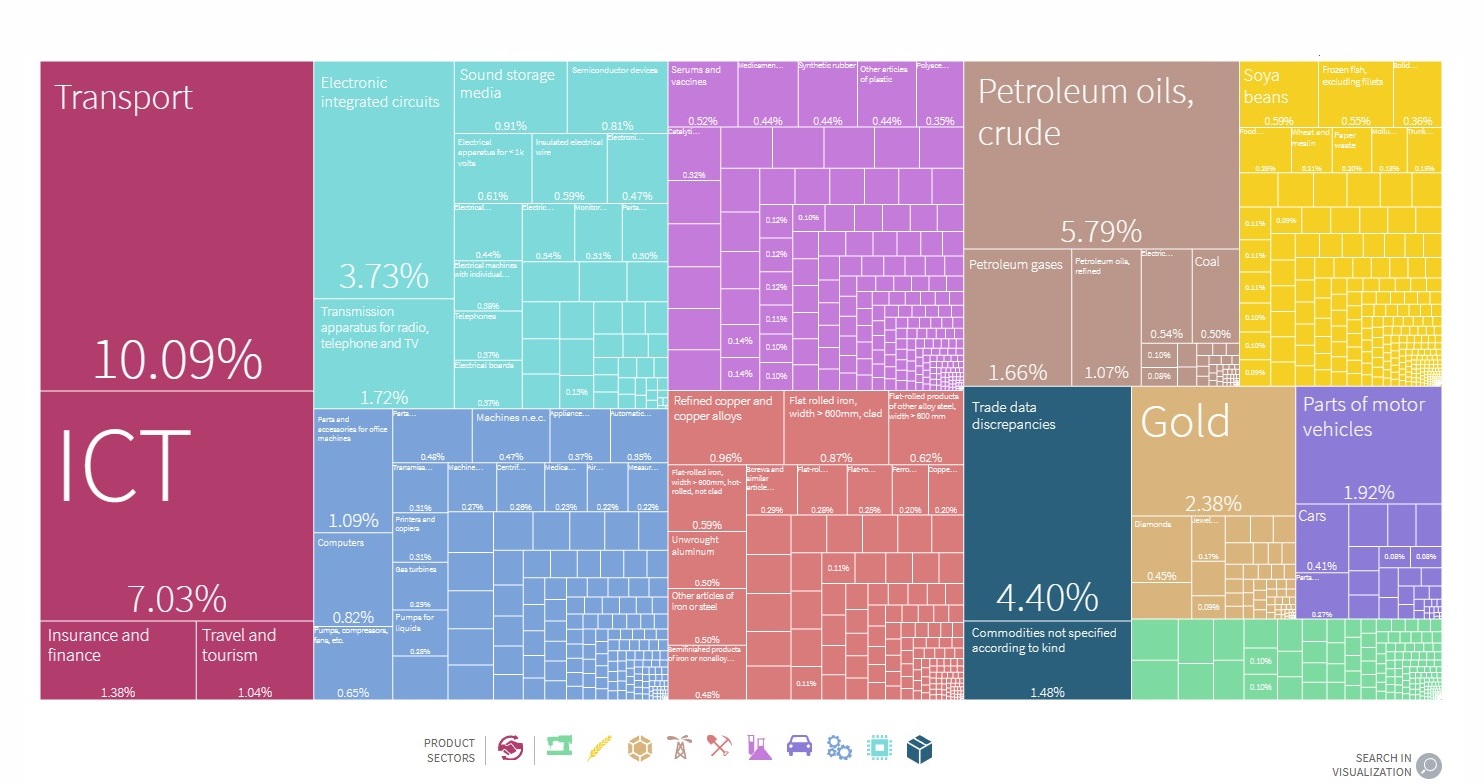
Source - The Atlas of Economic Complexity (harvard.edu)
The following are the main goods and services imported by Thailand in 2021
Services
Transport - 10.9%
Information and communication technologies - 7.03%
Insurance and finance - 1.38%
Tourism - 1.04%
Electronics
Electronic integrated circuits - 3.73%
Transmitting equipment for radio, telephone and television - 1.72%
Audio players— 0.91%
Appliances
Spare parts and accessories for office equipment -1.09%
Computers -0.82%
Pumps, compressors, fans, etc. — 0.63%
Chemical industry
Sera and vaccines - 0.52%
Medicines - 0.44%
Synthetic rubber - 0.44%
Metallurgy
Refined copper and copper alloys - 0.96%
Flat rolled products, width > 600 mm, clad - 0.87%
Flat rolled products from other alloy steels with a width > 600 mm - 0.62%
Minerals
Crude petroleum oils - 5.79%
Petroleum gas - 1.66%
Refined petroleum oils - 1.07%
Agro-industrial complex
Soybeans - 0.59%
Frozen fish, except fillets – 0.55%
Transport
Cars - 0.41%
Automotive parts - 1.92%
Why the Thai baht is one of the most stable world currencies
Why the Thai baht is one of the most stable world currencies
Over the past 20 years, the Thai Baht has proven itself to be a reliable currency. Over the past two decades, the dollar to baht exchange rate continues to remain at a stable level with minimal fluctuations. This stability of the Thai currency allows foreign investors to be confident in their deposits and not worry that the invested funds may depreciate due to the jump in the dollar/baht exchange rate.
Baht to dollar exchange rate 2005 - 2023
The graph below shows the dynamics of the dollar to baht exchange rate by year over the past 18 years. Throughout this time, the exchange rate fluctuates between 30 - 36 baht per 1 US dollar.
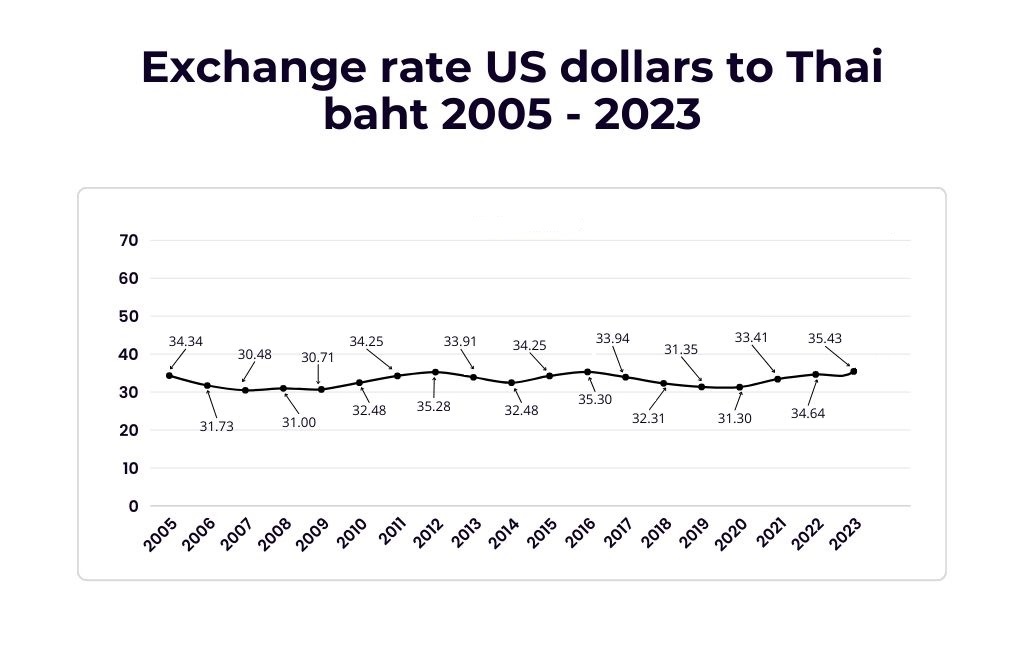
Source -Thai Baht (THB) to US Dollar (USD) exchange rate history (exchangerates.org.uk)
It is also worth noting that transactions in foreign currency are prohibited in the country. All settlements for transactions are made in national currency, which provides the Thai baht with additional stability in the world market. Thailand's currency was ranked the 10th most commonly used payment currency in the world in 2017.
Inflation in Thailand
In September 2023, Thailand's inflation rate fell to 0.3%, down from 0.9% in August of the same year, making it the lowest of any Southeast Asian country (Source - Inflation in Thailand falls to 0.30% in September, lowest in Southeast Asia (nationthailand.com)
Over the past 10 years, Thailand's inflation rate has continued to be one of the lowest in the world. In 2023, the inflation rate in Thailand varies between 0.7 - 1.5%. At the same time, despite such low inflation rates and the periodic transition of the country's economy from inflation to deflation, the Thai government manages to maintain the inflation rate at a consistently low level from year to year. Deflation itself in the short term can have a beneficial effect on the money invested by an investor, but at the same time it has a very negative impact on the country’s economy in the long term, since due to the gradual rise in price of the money supply, economic entities are less motivated to spend money. In recent years, deflation in Thailand was observed only in 2020 and amounted to -0.84%.
The image below shows a graph of inflation rate fluctuations from 2019 to 2023.
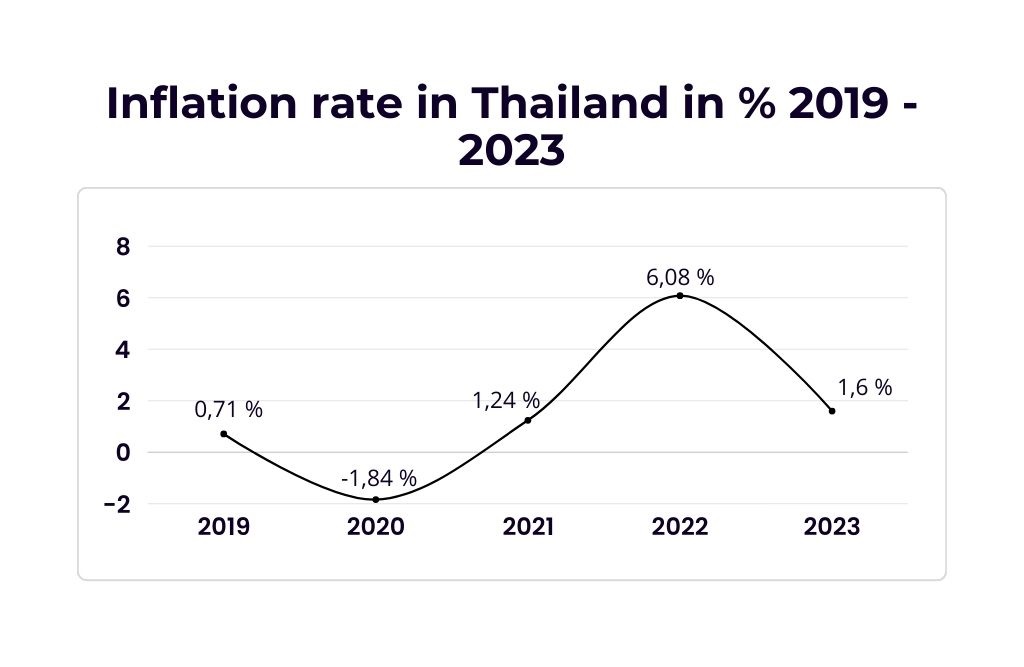
Source - Thailand Inflation Rate (tradingeconomics.com)
Inflation in Thailand by year:
In 2019 - 0.71%
In 2020 - -0.84%
In 2021 - 1.24%
In 2022 - 6.08%
In 2023 - 1.6%
Other factors affecting the stability of the Thai baht
The Thais themselves are very friendly and peace-loving people. They prefer to remain neutral during world military conflicts. This also has a beneficial effect on the stability of the Thai currency and does not impose sanctions restrictions or other negative consequences of military actions on the economy.
During the colonial expansion of European empires in southeast Asia, Thailand was not colonized. Thais are very proud of this fact and for good reason. Thanks to this, they managed to retain power in their country and preserve their national identity. As a result of the expansion of Europeans in the north, Thailand bordered the British colony, where modern Myanmar (Burma) is now located. In the east there was a French colony in the territory of modern Cambodia and Vietnam. During that period of time, the Thais managed to very cleverly maneuver between the two empires without bringing the burden of colonization on their territories.
It is also worth noting the consequences of the pandemic, which did not pass Thailand by. Covid restrictions have completely stopped the tourism sector of the country's economy. The government managed to lift all Covid restrictions only towards the end of 2022. Fortunately, immediately after the restrictions were lifted, tourists returned to Thailand and most of the companies associated with this sector resumed their work. With the return of tourists, the country began a construction boom for investment properties in regions such as Phuket, Pattaya and Samui. The local population and foreigners have again begun to actively invest in real estate for further rental or resale.
Undersun Estate is an expert in the residential and investment real estate market. Phuket, Thailand. We will be happy to help you select real estate, help you think through your investment strategy and lead you to earn money in a stable currency. Leave a request on the website and our manager will contact you shortly.
